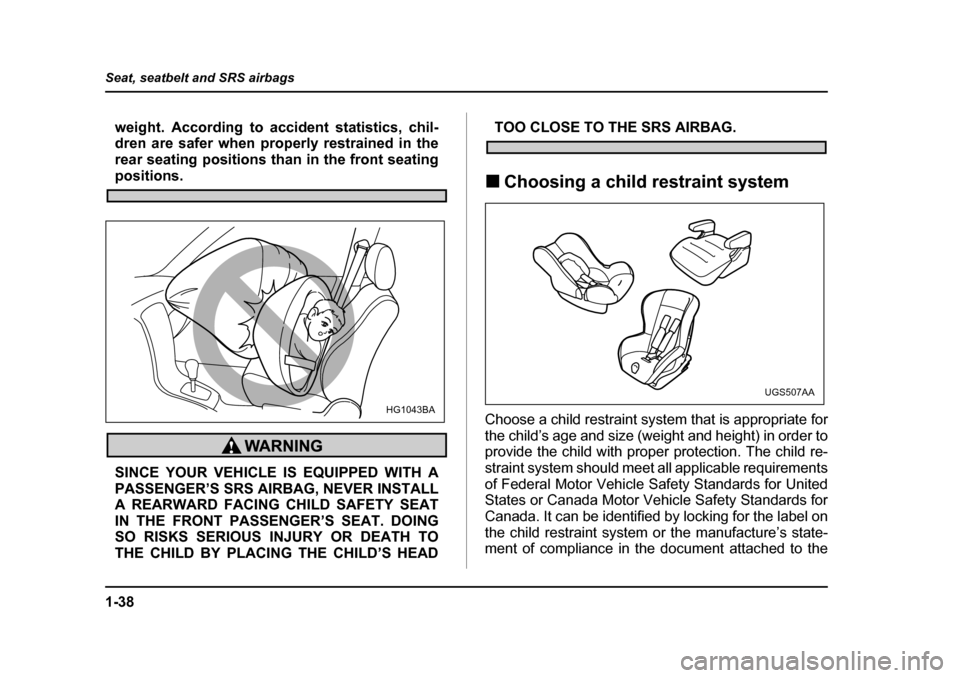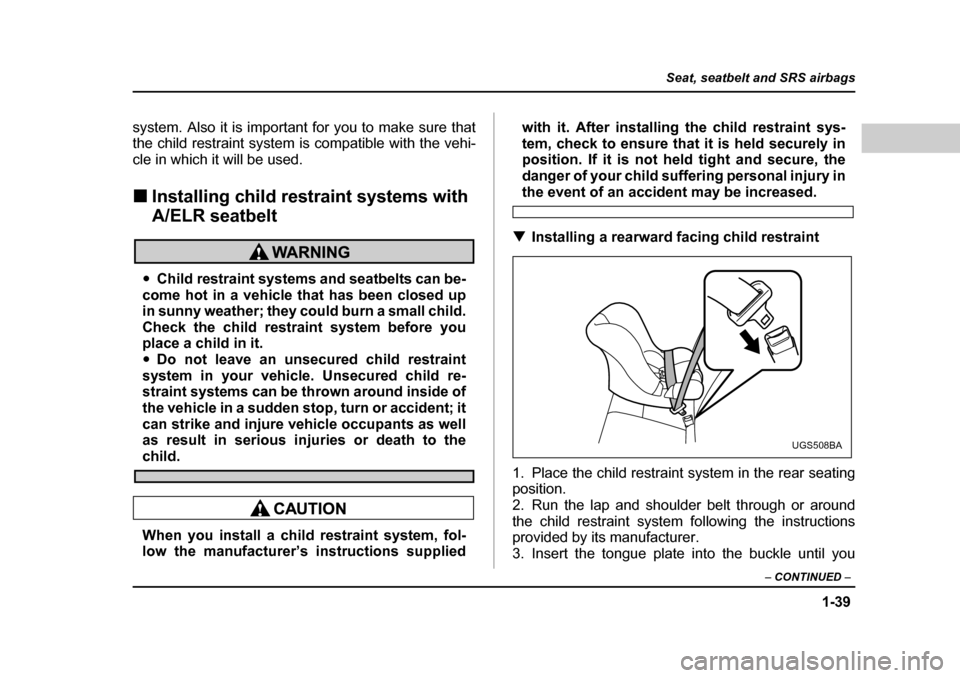Page 66 of 477

1-33
Seat, seatbelt and SRS airbags
– CONTINUED –
fore, if any malfunction occurs in a seatbelt preten-
sioner, the SRS airbag system warning light will illumi-
nate. The SRS airbag system warning light will show
normal system operation by lighting for about 6 sec-
onds when the ignition key is turned to the “ON” posi-tion.
The following components are monitored by the indi-
cator:�yFront sub sensor (Right hand side)
�y Front sub sensor (Left hand side)
�y Side airbag sensor (Driver’s side)
�y Side airbag sensor (Passenger’s side)
�y Airbag control module (including impact sensors)
�y Seatbelt pretensioner (Driver’s side)
�y Seatbelt pretensioner (Passenger’s side)
�y All related wiring
�y And all other airbag components
If the warning light exhibits any of the following
conditions, there may be a malfunction in the
seatbelt pretensioners and/or SRS airbag sys-
tem. Immediately take your vehicle to your
nearest SUBARU dealer to have the system
checked. Unless checked and properly re-
paired, the seatbelt pretensioners and/or SRS airbags will operate improperly (e.g. SRS air-
bags may inflate in a very minor collision or not
inflate in a severe collision), which may in-
crease the risk of injury. �y
Flashing or flickering of the indicator light
�y No illumination of the warning light when the
ignition switch is first turned to the “ON” posi-tion�y Continuous illumination of the warning light
�yIllumination of the warning light while driving
�„ System servicing
�yWhen discarding a seatbelt retractor assem-
bly or scrapping the entire vehicle damaged by
a collision, consult your SUBARU dealer. �y Tampering with or disconnecting the sys-
tem’s wiring could result in accidental activa-
tion of the seatbelt pretensioner and/or SRS air-
bag or could make the system inoperative,
which may result in serious injury. The wiring
harnesses of the seatbelt pretensioner and SRS
airbag systems are covered with yellow insula-
tion and the connectors of the system are yel-
Page 67 of 477

1-34
Seat, seatbelt and SRS airbags
low for easy identification. Do not use electrical
test equipment on any circuit related to the
seatbelt pretensioner and SRS airbag systems.
For required servicing of the seatbelt preten-
sioner, see your nearest SUBARU dealer.
The front sub sensors are located near the bot-
tom of the radiator and the side airbag sensor
is located inside each center pillar and the SRS
airbag control module including the impact
sensors is located under the center console. If
you need service or repair in those areas or
near the front seatbelt retractors, we recom-
mend that you have an authorized SUBARU
dealer perform the work.
NOTE
If the front part of the vehicle is damaged in an ac-
cident to the extent that the seatbelt pretensioner
does not operate, contact your SUBARU dealer as
soon as possible.
�„
Precautions against vehicle modifica- tion
Always consult your SUBARU dealer if you want to in-
stall any accessory parts to your vehicle.
Do not perform any of the following modifica-
tions. Such modifications can interfere with
proper operation of the seatbelt pretensioners.�y Attachment of any equipment (bush bar,
winches, snow plow, skid plate, etc.) other than
genuine SUBARU accessory parts to the front
end. �y Modification of the suspension system or
front end structure. �y Installation of a tire of different size and con-
struction from the tires specified on the tire
placard attached to the driver’s door jamb.
Page 68 of 477

1-35
Seat, seatbelt and SRS airbags
– CONTINUED –
Child restraint systems
Infants and small children should always be placed in
an infant or child restraint system in the rear seat while
riding in the vehicle. You should use an infant or child
restraint system that meets Federal Motor Vehicle
Safety Standards or Canada Motor Vehicle Safety
Standards, is compatible with your vehicle and is ap-
propriate for the child’s age and size. All child restraint
systems are designed to be secured in vehicle seats
by lap belts or the lap belt portion of a lap/shoulder belt
(except those covered under the section in this manu-
al, entitled “Installation of child restraint systems by
use of lower and tether anchorages (LATCH)”). Children could be endangered in an accident if their
child restraints are not properly secured in the vehicle.
When installing the child restraint system, carefully fol-
low the manufacturer’s instructions.
According to accident statistics, children are safer
when properly restrained in the rear seating positions
than in the front seating positions.
All U.S. states and Canadian provinces require that in-
fants and small children be restrained in an approved
child restraint system at all times while the vehicle is moving.
US1114BA
HS1069BA
Page 69 of 477
1-36
Seat, seatbelt and SRS airbags
Never let a passenger hold a child on his or her
lap or in his or her arms while the vehicle is
moving. The passenger cannot protect the
child from injury in a collision, because the
child will be caught between the passenger and
objects inside the vehicle.
Additionally, holding a child in your lap or arms
in the front seat exposes that child to another
serious danger. Since the SRS airbag deploys
with considerable speed and force, the child
could be injured or even killed.
Children should be properly restrained at all
times. Never allow a child to stand up, or to
kneel on any seat. Unrestrained children will be
thrown forward during sudden stop or in an ac-
cident and can be injured seriously.
Additionally, children standing up or kneeling
on or in front of the front seat are exposed an-
other serious danger. Since the SRS airbag de-
ploys with considerable speed and force, the
child could be injured or even killed.
HS1070BA
Page 70 of 477

1-37
Seat, seatbelt and SRS airbags
– CONTINUED –
�„Where to place a child restraint system
The following are SUBARU’s recommendations on
where to place a child restraint system in your vehicle.
A: Front passenger’s seat
You should not install a child restraint system due to
the hazard to children posed by the passenger’s air-
bag.
B: Rear seat, window-side seating positions
Recommended positions for all types of child restraint systems.
In these positions, Automatic/Emergency Locking Re-
tractor (A/ELR) seatbelts and lower anchorages (bars)
are provided for installing a child restraint system. C: Rear seat, center seating position
Installing a child restraint system is not recommended,
although the A/ELR seatbelt is provided in this posi-
tion.
Some types of child restraints might not be able to be
secured firmly due to projection of the seat cushion.
In this seating position, you should use only a child re-
straint system that has a bottom base that fits snugly
against the contours of the seat cushion and can be
securely retained using the seatbelt.
Put children aged 12 and under in the rear seat
properly restrained at all times. The SRS airbag
deploys with considerable speed and force and
can injure or even kill children, especially if
they are 12 years of age and under and are not
restrained or improperly restrained. Because
children are lighter and weaker than adults,
their risk of being injured from deployment is
greater.
For that reason, be sure to secure ALL types of
child restraint devices (including forward fac-
ing child seats) in the REAR seats at all times.
You should choose a restraint device which is
appropriate for the child’s age, height and
US1575AA
Page 71 of 477

1-38
Seat, seatbelt and SRS airbags
weight. According to accident statistics, chil-
dren are safer when properly restrained in the
rear seating positions than in the front seating
positions.
SINCE YOUR VEHICLE IS EQUIPPED WITH A PASSENGER’S SRS AIRBAG, NEVER INSTALL
A REARWARD FACING CHILD SAFETY SEAT
IN THE FRONT PASSENGER’S SEAT. DOINGSO RISKS SERIOUS INJURY OR DEATH TO
THE CHILD BY PLACING THE CHILD’S HEAD
TOO CLOSE TO THE SRS AIRBAG.
�„ Choosing a child restraint system
Choose a child restraint system that is appropriate for
the child’s age and size (weight and height) in order to
provide the child with proper protection. The child re-
straint system should meet all applicable requirements
of Federal Motor Vehicle Safety Standards for United
States or Canada Motor Vehicle Safety Standards for
Canada. It can be identified by locking for the label on
the child restraint system or the manufacture’s state-
ment of compliance in the document attached to the
HG1043BA
UGS507AA
Page 72 of 477

1-39
Seat, seatbelt and SRS airbags
– CONTINUED –
system. Also it is important for you to make sure that
the child restraint system is compatible with the vehi-
cle in which it will be used. �„Installing child restraint systems with
A/ELR seatbelt
�yChild restraint systems and seatbelts can be-
come hot in a vehicle that has been closed up
in sunny weather; they could burn a small child.
Check the child restraint system before you
place a child in it. �y Do not leave an unsecured child restraint
system in your vehicle. Unsecured child re-
straint systems can be thrown around inside of
the vehicle in a sudden stop, turn or accident; it
can strike and injure vehicle occupants as well
as result in serious injuries or death to the
child.
When you install a child restraint system, fol-
low the manufacturer’s instructions supplied with it. After installing the child restraint sys-
tem, check to ensure that it is held securely in
position. If it is not held tight and secure, the
danger of your child suffering personal injury in
the event of an accident may be increased.
�T Installing a rearward facing child restraint
1. Place the child restraint system in the rear seating
position.
2. Run the lap and shoulder belt through or around
the child restraint system following the instructions
provided by its manufacturer.
3. Insert the tongue plate into the buckle until you
UGS508BA
Page 73 of 477
1-40
Seat, seatbelt and SRS airbags
hear a click.
4. Take up the slack in the lap belt.
5. Pull out the seatbelt fully from the retractor to
change the retractor over from the Emergency Lock-
ing Retractor (ELR) to the Automatic Locking Retrac-
tor (ALR) function. Then, allow the belt to rewind into
the retractor. As the belt is rewinding, clicks will be
heard which indicate the retractor functions as ALR.
6. Push and pull the child restraint system forward
and from side to side to check if it is firmly secured.
Sometime a child restraint can be more firmly secured
by pushing it down into the seat cushion and then
tightening the seatbelt.
7. Pull at the shoulder portion of the belt to confirm
that it cannot be pulled out (ALR properly functioning).
UGS509BAUGS510BA